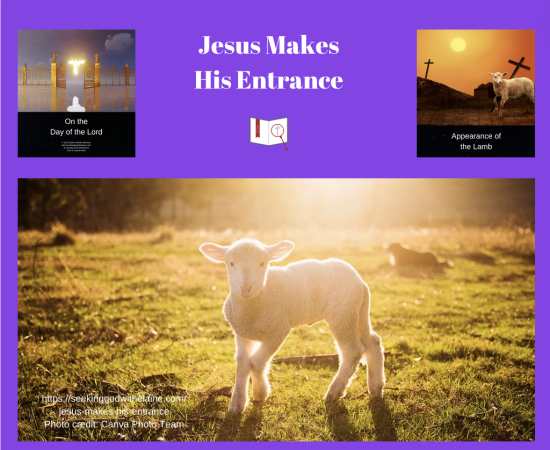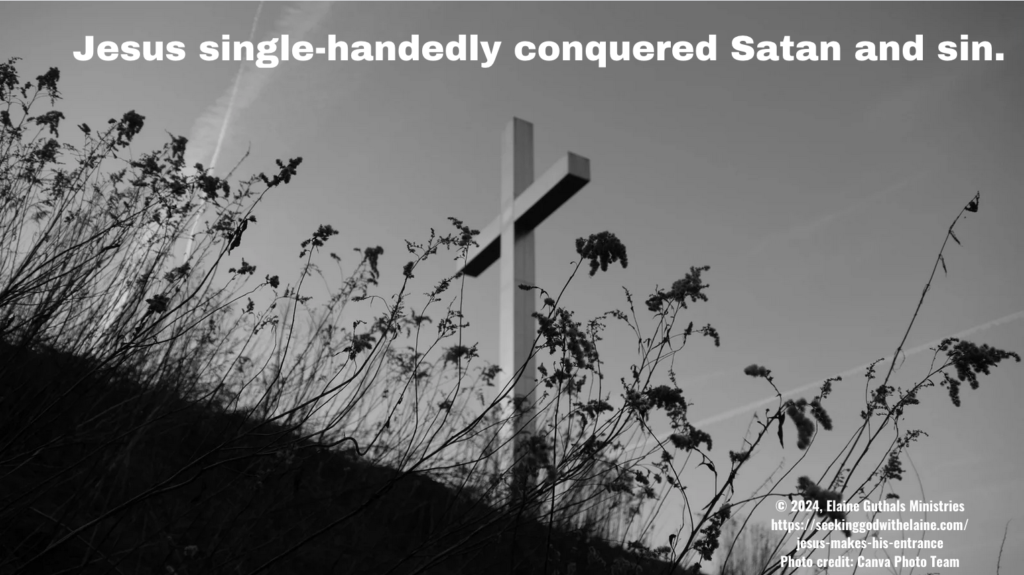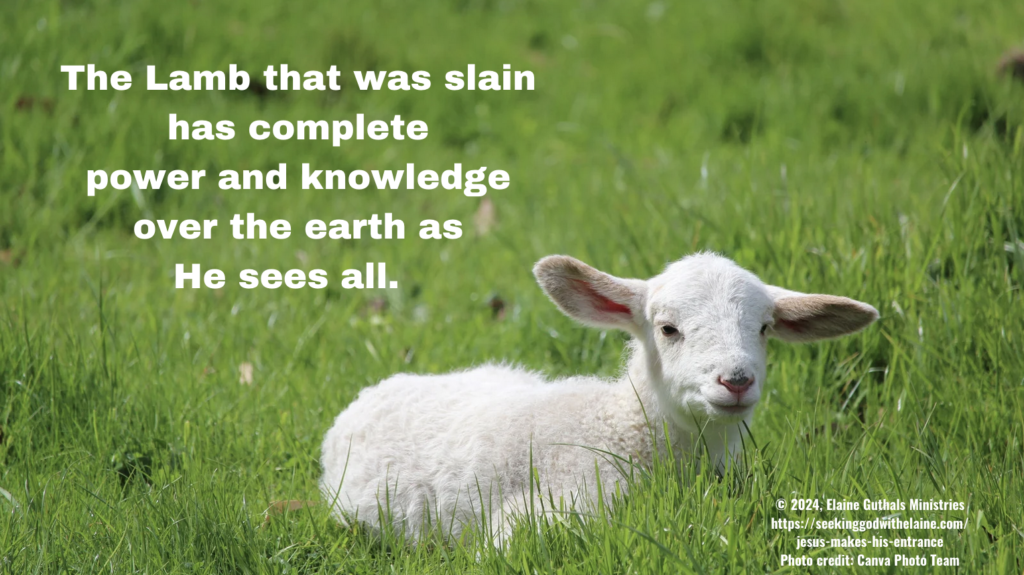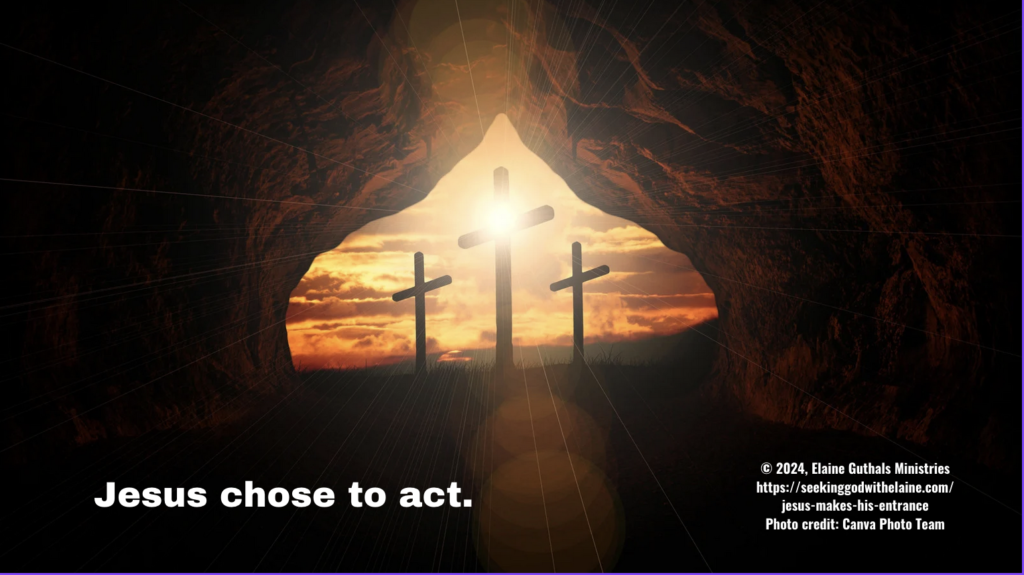The scene in Heaven is missing One important player. This devotional reading looks at the appearance of the Lamb.
Nuggets
- Jesus was always at the center.
- Jesus is a man of action.

We’ve been slowly setting the scene in Heaven after John walked through the door. God is on His throne. The living creatures and elders surround the throne along with the seven Spirits – the Holy Spirit.
Who is missing? The Lamb is.
It is finally time for the Lamb to make His entrance.
Let's Put It into Context
To read devotions in the On the Day of the Lord theme, click the button below.
Devotions in the The Appearance of the Lamb series
The Appearance of the Lamb
“And between the throne and the four living creatures and among the elders I saw a Lamb standing, as though it had been slain, with seven horns and with seven eyes, which are the seven spirits of God sent out into all the earth” (Rev. 5: 6 ESV)
Jesus was always at the center.
In the Midst of the Throne
Jesus was instrumental in creation. “And he is before all things, and in him all things hold together” (Col. 1: 17 ESV).
From even before creation, Jesus was the basis of the Plan of Salvation. “Blessed be the God and Father of our Lord Jesus Christ, who has blessed us in Christ with every spiritual blessing in the heavenly places, even as he chose us in him before the foundation of the world, that we should be holy and blameless before him …” (Eph. 1: 3-4 ESV).
Spurgeon said that this means Jesus sums up all existence. That is one reason that explains why Jesus is in the center with all eyes upon Him.
Resource
Sometimes, the center is called the nucleus. It is the most important part of the group.
That is why it is in the middle of all. It gives Jesus the honor and dignity He deserves.
Through the nucleus, growth occurs. Growth is important.
If we are not growing, we are not growing closer to God and becoming more like Him. In fact, if we are not growing, we are dying.
“My people are destroyed for lack of knowledge; because you have rejected knowledge, I reject you from being a priest to me. And since you have forgotten the law of your God, I also will forget your children” (Hos. 4: 6 ESV).
The knowledge that we must gain is about Jesus being our Savior and Redeemer. We must learn how we are to imitate Him.
In order to grow, we have to keep Jesus in the center of our lives and hearts. We have to keep looking up to Him.
There is another practical reason that Jesus is in the middle. One of His duties is to be Mediator for us. He does need to be in the middle of it all to do that.
Exell had a good explanation of why Jesus was in the midst of the throne. He wrote,
“We are assured that Christ is not merely the [center] of the society of heaven because of His royal dignity, but also because of the beauty of His character, the glory of His redemptive work, the wealth of His mercy, the depth of His condescension, and the wondrous achievements of His grace in bringing so many to the promised kingdom.”
Resource
Jesus is everything, just as God is everything. The one that stands out for me is the talk about the beauty of His character.
Jesus and God are pure. We are to strive to be like Them.
Lamb that Was Slain
We know that the Lamb that was slain was a title for Jesus.
But it is interesting. From what I could find, this title was only used once in the Old Testament.
“He was oppressed, and he was afflicted, yet he opened not his mouth; like a lamb that is led to the slaughter, and like a sheep that before its shearers is silent, so he opened not his mouth” (Isa. 53: 7 ESV).
That is probably the most recognizable one for us. But it just dawned on me.
God’s Word set the provision that there had to be two or three witnesses saying the same thing before the testimony was deemed reliable.
God doesn’t need two or three witnesses. He will always speak truth.
John the Baptist called Jesus the Lamb of God, but he didn’t really say anything about Him being slain. “The next day he saw Jesus coming toward him, and said, ‘Behold, the Lamb of God, who takes away the sin of the world!’” (Jn. 1: 29 ESV).
Peter sort of hinted around at the title. “knowing that you were ransomed from the futile ways inherited from your forefathers, not with perishable things such as silver or gold, but with the precious blood of Christ, like that of a lamb without blemish or spot” (I Pet. 1: 18-19 ESV).
True, Peter wrote his letter after Jesus’ death, resurrection, and ascension.
The only other usages of the title I could find occur in Revelation.
- “And between the throne and the four living creatures and among the elders I saw a Lamb standing, as though it had been slain, with seven horns and with seven eyes, which are the seven spirits of God sent out into all the earth” (Rev. 5: 6 ESV).
- “Saying with a loud voice, ‘Worthy is the Lamb who was slain, to receive power and wealth and wisdom and might and honor and glory and blessing!’” (Rev. 5: 12 ESV).
- “And all who dwell on earth will worship it, everyone whose name has not been written before the foundation of the world in the book of life of the Lamb who was slain” (Rev. 13: 8 ESV).
So, all the usages of the title the Lamb that was slain was, really, when God Himself used them.
Wouldn’t this be a kick? First-century Jews would have loved the Messiah being identified as the Lion of Judah (Rev. 5: 5).
They didn’t see the Messiah as the Lamb — let alone the Lamb that was slain. They equated lambs with sacrifices. The Suffering Savior wasn’t anywhere on their radar, even though they knew Isaiah 53.
Matheson explained it this way. He wrote,
“The Jew would have understood a lion on the throne, for his Messiah was a physical conqueror. But the lamb was ever victim, the symbol of the vanquished, the sign of the dependent soul. Its place was not the throne, but the altar; it could never be the emblem of dominion.”
Resource
But the first-century Jews got it all wrong – much like the Church is doing today.
If Jesus wasn’t the Sacrificial Lamb, He would not be the Savior of the world. It is only through His blood that we are cleansed.
More than that, the Sacrificial Lamb is glorified in Hs resurrection. He is given a place of honor by the Ancient One’s throne.
Why is all this important? A couple of devotions ago, we were talking about the plan on the scroll. This was an extensive plan.
Christ is the One Who is going to accomplish it. We would probably say that He is the administrator of it.
Jesus always saw Himself as the Servant of God. He never did anything that God didn’t tell Him to do. He always did everything God told Him to do.
In other words, Jesus always followed God’s plan — even when that plan led to suffering.
The best example of that is when Jesus followed God’s plan to His death.
Let’s go back a second to the Lion of Judah and the Lamb that was slain. John’s use of both gives us a complete view of Who Jesus is. We wouldn’t really want the one without the other.
We need the Lamb Who was slain for salvation. We need His gentle mercy.
But we definitely need the Lion of Judah. Yes, we hear repeatedly about Jesus being meek.
Jesus single-handedly conquered Satan and sin. No wimp is going to do defeat Satan and sin single-handedly.

We need to see how the Lion of Judah approaches His trials and rejections.
Think about this from John’s perspective.
- He saw Jesus as a man – and as a Friend.
- He saw Jesus crucified.
- He saw Jesus resurrected.
- He saw Jesus ascending.
- He is seeing Jesus as a Conqueror and glorified.
Seven Horns and Seven Eyes
We think of the seven horns and seven eyes as a funky description. It really isn’t.
The Lamb that was slain has complete power and knowledge over the earth as He sees all. In addition, He is a King and a Priest.

This also ties on with Zechariah 3 and 4.
“And the angel of the Lord solemnly assured Joshua, ‘Thus says the Lord of hosts: If you will walk in my ways and keep my charge, then you shall rule my house and have charge of my courts, and I will give you the right of access among those who are standing here. Hear now, O Joshua the high priest, you and your friends who sit before you, for they are men who are a sign: behold, I will bring my servant the Branch. For behold, on the stone that I have set before Joshua, on a single stone with seven eyes, I will engrave its inscription, declares the Lord of hosts, and I will remove the iniquity of this land in a single day” (Zech. 3: 6-9 ESV emphasis added).
We know Jesus is the cornerstone. “Jesus said to them, ‘Have you never read in the Scriptures: “The stone that the builders rejected has become the cornerstone; this was the Lord’s doing, and it is marvelous in our eyes”?’” (Mt. 21: 42 ESV).
Okay, but the sentence doesn’t stop there. “… I saw a Lamb standing, as though it had been slain, with seven horns and with seven eyes, which are the seven spirits of God sent out into all the earth” (Rev. 5: 6 ESV).
We’ve ran into the term seven spirits of God a couple of times already.
- “… Grace to you and peace from him who is and who was and who is to come, and from the seven spirits who are before his throne” (Rev. 1: 4 ESV).
- “And to the angel of the church in Sardis write: ‘The words of him who has the seven spirits of God and the seven stars” (Rev. 3: 1 ESV).
- “From the throne came flashes of lightning, and rumblings and peals of thunder, and before the throne were burning seven torches of fire, which are the seven spirits of God” (Rev. 4: 5 ESV).
We’ve talked that, while most believe the seven spirits refer to the Holy Spirit, some think it refers to Jesus Himself.
Revelation 5: 6 does connect Jesus with the Holy Spirit. “… a Lamb [which] had been slain, … with seven eyes, which are the seven spirits of God sent out into all the earth” (Rev. 5: 6 ESV).
Just as God and Jesus are One, Jesus and the Holy Spirit are One – but they’re not. They are three distinct Persons within one indivisible Divine nature.
Both have been sent to earth, just at different times. Jesus made it clear that the Holy Spirit couldn’t come to earth until He had left. “Nevertheless, I tell you the truth: it is to your advantage that I go away, for if I do not go away, the Helper will not come to you. But if I go, I will send him to you” (Jn. 16: 7 ESV).
I see part of the function of the Holy Spirit as being the One Who connects us with Jesus now. He gives us access to the Christ – access we wouldn’t have after His ascension.
The Holy Spirit leads us to Jesus. We walk with Jesus by walking with the Spirit.

We have to understand what is meant by the word sent. We just see it in the past tense.
Here, it really means being sent. God sends the Holy Spirit daily when we take up our cross daily (Lk. 9: 23).
Does that mean the Holy Spirit puts in His 8 to 5, clocks out, and goes home? No.
The Holy Spirit is always with us when we are God’s children. But just as His mercies are new every morning (Lam 3: 22-23), the presence of the Holy Spirit is renewed.
The Action of the Lamb
“And he went and took the scroll from the right hand of him who was seated on the throne” (Rev. 5: 7 ESV)
Jesus is a man of action.
We focus so much on the fact that Jesus is the only One Who could be the Savior. Only He was worthy enough to open the seals.
We often don’t consider that Jesus could have said no.
Jesus chose to act.

By opening the seals, Jesus is still being God’s Messenger. Look at what Spurgeon had to say. He wrote, “We observe, in addition to all this, that He is the prophet of God. ‘He who unveils the eternal will of the Highest is the Lamb of God which taketh away the sin of the world.’”
Resource
Everything Jesus did for us was out of love. He loves us enough to have sacrificed Himself so that we could be restored to a right relationship with God.
Let’s not miss something. What we get here is affirmation that God and Jesus are two distinct Persons but one God. Jesus took the scroll from God Himself.
Making the Connections #1
McCosh reminded us that nothing in this scene diminished or negated the method of atonement. Jesus shed His blood to pay for our sins.
Resource
Only Jesus could be the Sacrificial Lamb. Only Jesus could open the seals.
Salvation only comes through our repentance and transformation. Those only come through God’s grace.
We must acknowledge and turn away from sin. We must navigate the Sanctification Road so that we become more like God.
In other words, we need to gain God’s character.
Making the Connections #2
I have to process what Matheson said. He wrote,
“The Christ who has risen from the grave is not Christ who has triumphed over suffering; it is a Christ in whom suffering has triumphed. … If the empire to be conquered be a physical one, it is not a lamb that will do it. No man who looked for a physical conquest could for a moment have conceived the simile of a world held in restraint by the power of a sacrificial life.”
Resource
Jesus didn’t conquer suffering. He completed the Plan of Salvation because He suffered.
Conquering suffering would make it a worldview thing. We suffer in this world.
The conquering of suffering would make Jesus a social savior. Jesus was our spiritual Savior.
But, as Matheson said, that leads to the conquering of our hearts.
Ooo, baby. Talk about unruly!
We have to choose to submit our hearts, souls, minds, and strength to Jesus.
How Do We Apply This?
The ABCDs of Salvation
If you have not become a believer in Christ, please read through the
Plan of Salvation and prayerfully consider what God is asking you to do.
A – admit our sins
B – believe His Son Jesus is our Redeemer
C – confess God as Sovereign Lord
D – demonstrate that commitment by making any changes needed in our lives to live the way in which God has called us
The Disciple’s Job Description
Father God. We are humbled that Jesus, Your Son, chose to act on our behalf. He chose to give His life so that we could be restored to You. He is – and always was – worthy. We are not. Yet, He chose to give His life at Calvary so that we will one day see Him seated on His throne. We can’t wait. Amen.
What do you think?
Leave me a comment below (about this or anything else) or head over to my Facebook group for some interactive discussion.
If you don’t understand something and would like further clarification, please contact me.
If you have not signed up for the email providing the link to the devotions and the newsletter, do so below.
If God has used this devotion to speak with you, consider sharing it on social media.